Analysis of Scientometric Indicators in Publications Associated with Healthy Aging in the World, Period 2011–2020
Abstract
:1. Introduction
2. Methodology
3. Results
3.1. Productivity
3.2. Visibility and Impact
3.3. Collaborations
4. Discussion
5. Conclusions
Author Contributions
Funding
Institutional Review Board Statement
Informed Consent Statement
Data Availability Statement
Conflicts of Interest
References
- Eckstrom, E.; Neukam, S.; Kalin, L.; Wright, J. Physical Activity and Healthy Aging. Clin. Geriatr. Med. 2020, 36, 671–683. [Google Scholar] [CrossRef] [PubMed]
- Fuentes, E.; Fuentes, M.; Alarcón, M.; Palomo, I. Immune System Dysfunction in the Elderly. An. Acad. Bras. Ciências 2017, 89, 285–299. [Google Scholar] [CrossRef] [Green Version]
- Moguel, E.; Berrocal, J.; Garcia-Alonso, J. Systematic Literature Review of Food-Intake Monitoring in an Aging Population. Sensors 2019, 19, 3265. [Google Scholar] [CrossRef] [PubMed] [Green Version]
- Fuentes, F.; Palomo, I.; Fuentes, E. Platelet oxidative stress as a novel target of cardiovascular risk in frail older people. Vasc. Pharm. 2017, 93–95, 14–19. [Google Scholar] [CrossRef]
- Faller, J.W.; Teston, E.F.; Marcon, S.S. Conceptual structure of aging in different ethnicities. Rev. Gauch. Enferm. 2018, 39, e66144. [Google Scholar]
- Rosero-Bixby, L. Generational transfers and population aging in Latin America. Popul. Dev. Rev. 2011, 37 (Suppl. 1), 143–157. [Google Scholar] [CrossRef]
- Jin, K. New perspectives on healthy aging. Prog. Neurobiol. 2017, 157, 1. [Google Scholar] [CrossRef]
- Sadana, R.; Blas, E.; Budhwani, S.; Koller, T.; Paraje, G. Healthy Ageing: Raising Awareness of Inequalities, Determinants, and What Could Be Done to Improve Health Equity. Gerontologist 2016, 56 (Suppl. 2), S178–S193. [Google Scholar] [CrossRef] [Green Version]
- Jensen, L.; Monnat, S.M.; Green, J.J.; Hunter, L.M.; Sliwinski, M.J. Rural Population Health and Aging: Toward a Multilevel and Multidimensional Research Agenda for the 2020s. Am. J. Public Health 2020, 110, 1328–1331. [Google Scholar]
- James, P.; Kim, E.S.; Kubzansky, L.D.; Zevon, E.S.; Trudel-Fitzgerald, C.; Grodstein, F. Optimism and Healthy Aging in Women. Am. J. Prev. Med. 2019, 56, 116–124. [Google Scholar] [CrossRef]
- Brooks-Wilson, A.R. Genetics of healthy aging and longevity. Hum. Genet. 2013, 132, 1323–1338. [Google Scholar] [CrossRef] [PubMed] [Green Version]
- Sanchez-Izquierdo, M.; Fernandez-Ballesteros, R. Cognition in Healthy Aging. Int. J. Environ. Res. Public Health 2021, 18, 962. [Google Scholar] [CrossRef] [PubMed]
- Brivio, P.; Paladini, M.S.; Racagni, G.; Riva, M.A.; Calabrese, F.; Molteni, R. From Healthy Aging to Frailty: In Search of the Underlying Mechanisms. Curr. Med. Chem. 2019, 26, 3685–3701. [Google Scholar] [CrossRef] [PubMed]
- Rueda-Salazar, S.; Spijker, J.; Devolder, D.; Albala, C. The contribution of social participation to differences in life expectancy and healthy years among the older population: A comparison between Chile, Costa Rica and Spain. PLoS ONE 2021, 16, e0248179. [Google Scholar] [CrossRef] [PubMed]
- Calvo, E.; Berho, M.; Roqué, M.; Amaro, J.S.; Morales-Martinez, F.; Rivera-Meza, E.; Robledo, L.M.G.; López, E.C.; Canals, B.; Kornfeld, R. Comparative analysis of aging policy reforms in Argentina, Chile, Costa Rica, and Mexico. J. Aging Soc. Policy 2019, 31, 211–233. [Google Scholar] [CrossRef] [PubMed]
- Figueira, O.; Figueira, H.; Soleiman Franco, R.; Marcellini, P.S.; Sganzerla, A.; Corradi Perini, C. Quality of life in Brazilian elderly: An analysis of healthy aging from the perspective of Potter’s global bioethics. Glob. Bioeth. 2021, 32, 116–129. [Google Scholar] [CrossRef]
- Luo, W.; Deng, Z.; Zhong, S.; Deng, M. Trends, Issues and Future Directions of Urban Health Impact Assessment Research: A Systematic Review and Bibliometric Analysis. Int. J. Environ. Res. Public Health 2022, 19, 5957. [Google Scholar] [CrossRef]
- Pavlič, J.; Tomažič, T.; Kožuh, I. The impact of emerging technology influences product placement effectiveness: A scoping study from interactive marketing perspective. J. Res. Interact. Mark. 2021. [Google Scholar] [CrossRef]
- Scopus—Document Search. 2022. Available online: https://www.scopus.com/ (accessed on 5 January 2022).
- Elsevier. Elsevier|An Information Analytics Business|Empowering Knowledge. 2021. Available online: https://www.elsevier.com/home (accessed on 6 January 2022).
- Elsevier. SciVal—Home. 2022. Available online: https://scival.com/home (accessed on 6 January 2022).
- Scimago. Scimago Journal & Country Rank. 2022. Available online: https://www.scimagojr.com/ (accessed on 10 January 2022).
- Microsoft. Software de Hojas de Cálculo Microsoft Excel|Microsoft 365. 2022. Available online: https://www.microsoft.com/es-cl/microsoft-365/excel (accessed on 10 January 2022).
- Van Eck, N.J.; Waltman, L. VOSviewer—Visualizing Scientific Landscapes. 2010. Available online: https://www.vosviewer.com/ (accessed on 24 January 2022).
- WBG. World Bank Group—International Development, Poverty, & Sustainability. 2022. Available online: https://www.worldbank.org/en/home (accessed on 10 March 2022).
- Villeda, S.A.; Luo, J.; Mosher, K.I.; Zou, B.; Britschgi, M.; Bieri, G.; Stan, T.M.; Fainberg, N.; Ding, Z.; Eggel, A.; et al. The ageing systemic milieu negatively regulates neurogenesis and cognitive function. Nature 2011, 477, 90–94. [Google Scholar] [CrossRef] [Green Version]
- Studenski, S.A.; Peters, K.W.; Alley, D.E.; Cawthon, P.M.; McLean, R.R.; Harris, T.B.; Ferrucci, L.; Guralnik, J.M.; Fragala, M.S.; Kenny, A.M.; et al. The FNIH sarcopenia project: Rationale, study description, conference recommendations, and final estimates. J. Gerontol. Ser. A Biomed. Sci. Med. Sci. 2014, 69, 547–558. [Google Scholar] [CrossRef]
- Deeks, S.G.; Lewin, S.R.; Havlir, D.V. The end of AIDS: HIV infection as a chronic disease. Lancet 2013, 382, 1525–1533. [Google Scholar] [CrossRef] [Green Version]
- Börsch-Supan, A.; Brandt, M.; Hunkler, C.; Kneip, T.; Korbmacher, J.; Malter, F.; Schaan, B.; Stuck, S.; Zuber, S. Data resource profile: The Survey of Health, Ageing and Retirement in Europe (SHARE). Int. J. Epidemiol. 2013, 42, 992–1001. [Google Scholar] [CrossRef]
- Pahor, M.; Guralnik, J.M.; Ambrosius, W.T.; Blair, S.; Bonds, D.E.; Church, T.S.; Espeland, M.A.; Fielding, R.A.; Gill, T.M.; Groessl, E.J.; et al. Effect of structured physical activity on prevention of major mobility disability in older adults: The LIFE study randomized clinical trial. JAMA 2014, 311, 2387–2396. [Google Scholar] [CrossRef] [PubMed]
- Powe, C.E.; Evans, M.K.; Wenger, J.; Zonderman, A.B.; Berg, A.H.; Nalls, M.; Tamez, H.; Zhang, D.; Bhan, I.; Karumanchi, S.A.; et al. Vitamin D—Binding protein and vitamin D status of black Americans and white Americans. N. Engl. J. Med. 2013, 369, 1991–2000. [Google Scholar] [CrossRef] [PubMed] [Green Version]
- Martin-Montalvo, A.; Mercken, E.M.; Mitchell, S.J.; Palacios, H.H.; Mote, P.L.; Scheibye-Knudsen, M.; Gomes, A.P.; Ward, T.M.; Minor, R.K.; Blouin, M.J.; et al. Metformin improves healthspan and lifespan in mice. Nat. Commun. 2013, 4, 2192. [Google Scholar] [CrossRef]
- Kanfi, Y.; Naiman, S.; Amir, G.; Peshti, V.; Zinman, G.; Nahum, L.; Bar-Joseph, Z.; Cohen, H.Y. The sirtuin SIRT6 regulates lifespan in male mice. Nature 2012, 483, 218–221. [Google Scholar] [CrossRef]
- Swanson, D.; Block, R.; Mousa, S.A. Omega-3 fatty acids EPA and DHA: Health benefits throughout life. Adv. Nutr. 2012, 3, 1–7. [Google Scholar] [CrossRef]
- Williams, A.R.; Hare, J.M. Mesenchymal stem cells: Biology, pathophysiology, translational findings, and therapeutic implications for cardiac disease. Circ. Res. 2011, 109, 923–940. [Google Scholar] [CrossRef] [Green Version]
- Kontis, V.; Bennett, J.E.; Mathers, C.D.; Li, G.; Foreman, K.; Ezzati, M. Future life expectancy in 35 industrialized countries: Projections with a Bayesian model ensemble. Lancet 2017, 389, 1323–1335. [Google Scholar] [CrossRef] [Green Version]
- Almeida, I.; Magalhaes, S.; Nunes, A. Lipids: Biomarkers of healthy aging. Biogerontology 2021, 22, 273–295. [Google Scholar] [CrossRef]
- Carmona, J.J.; Michan, S. Biology of Healthy Aging and Longevity. Rev. Investig. Clin. 2016, 68, 7–16. [Google Scholar]
- Hung, L.W.; Kempen, G.I.J.M.; de Vries, N.K. Cross-cultural comparison between academic and lay views of healthy ageing: A literature review. Ageing Soc. 2010, 30, 1373–1391. [Google Scholar] [CrossRef]
- Friedman, S.M. Lifestyle (Medicine) and Healthy Aging. Clin. Geriatr. Med. 2020, 36, 645–653. [Google Scholar] [CrossRef] [PubMed]
- Cardinali, D.P. Melatonin and healthy aging. Vitam. Horm. 2021, 115, 67–88. [Google Scholar] [PubMed]
- Willcox, D.C.; Scapagnini, G.; Willcox, B.J. Healthy aging diets other than the Mediterranean: A focus on the Okinawan diet. Mech. Ageing Dev. 2014, 136–137, 148–162. [Google Scholar] [CrossRef] [Green Version]
- Mazza, E.; Ferro, Y.; Pujia, R.; Mare, R.; Maurotti, S.; Montalcini, T.; Pujia, A. Mediterranean Diet In Healthy Aging. J. Nutr. Health Aging 2021, 25, 1076–1083. [Google Scholar] [CrossRef]
- Aronson, L. Healthy Aging across the Stages of Old Age. Clin. Geriatr. Med. 2020, 36, 549–558. [Google Scholar] [CrossRef]
- Yu, M.; Zhang, H.; Wang, B.; Zhang, Y.; Zheng, X.; Shao, B.; Zhuge, Q.; Jin, K. Key Signaling Pathways in Aging and Potential Interventions for Healthy Aging. Cells 2021, 10, 660. [Google Scholar] [CrossRef]
- Irwin, K.; Sexton, C.; Daniel, T.; Lawlor, B.; Naci, L. Healthy Aging and Dementia: Two Roads Diverging in Midlife? Front. Aging Neurosci. 2018, 10, 275. [Google Scholar] [CrossRef] [Green Version]
- Zamudio-Rodriguez, A.; Dartigues, J.-F.; Amieva, H.; Pérès, K. A Literature Review of Healthy Aging Trajectories through Quantitative and Qualitative Studies: A Psycho-epidemiological Approach on Community-dwelling Older Adults. J. Frailty Aging 2021, 10, 259–271. [Google Scholar]
- Forero-Peña, D.A.; Carrión-Nessi, F.S.; Camejo-Ávila, N.A.; Forero-Peña, M.J. COVID-19 in Latin America: A systematic review and bibliometric analysis. Rev. Salud Pública 2020, 22, e216. [Google Scholar]
- McManus, C.; Neves, A.A.B.; Maranhão, A.Q.; Filho, A.G.S.; Santana, J.M. International collaboration in Brazilian science: Financing and impact. Scientometrics 2020, 125, 2745–2772. [Google Scholar] [CrossRef] [PubMed]
- Yeung, S.S.Y.; Kwan, M.; Woo, J. Healthy Diet for Healthy Aging. Nutrients 2021, 13, 4310. [Google Scholar] [CrossRef]
- Marshall, J.C. Global Collaboration in Acute Care Clinical Research: Opportunities, Challenges, and Needs. Crit. Care Med. 2017, 45, 311–320. [Google Scholar] [CrossRef] [PubMed]
- Al-Aqeel, S.; Mendes, A.M.; Taisir, H.; Fernandez-Llimos, F. International collaboration in pharmacy practice research: A bibliometric analysis. Res. Soc. Adm. Pharm. 2020, 16, 1513–1518. [Google Scholar] [CrossRef] [PubMed]
- Sloan, S.S.; Alper, J. Data Matters: Ethics, Data, and International Research Collaboration in a Changing World: Proceedings of a Workshop; National Academies Press: Washington, DC, USA, 2018. [Google Scholar]

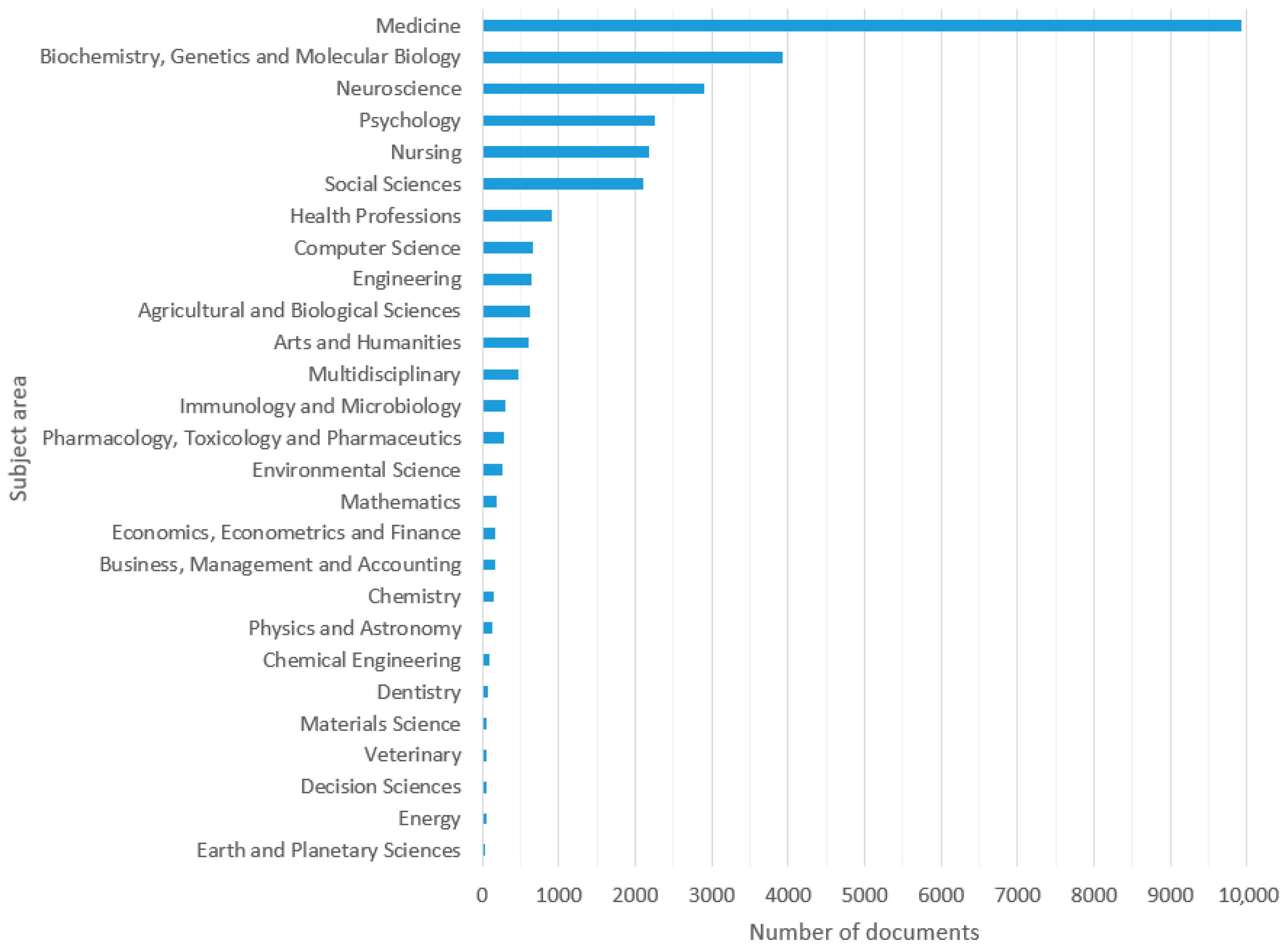
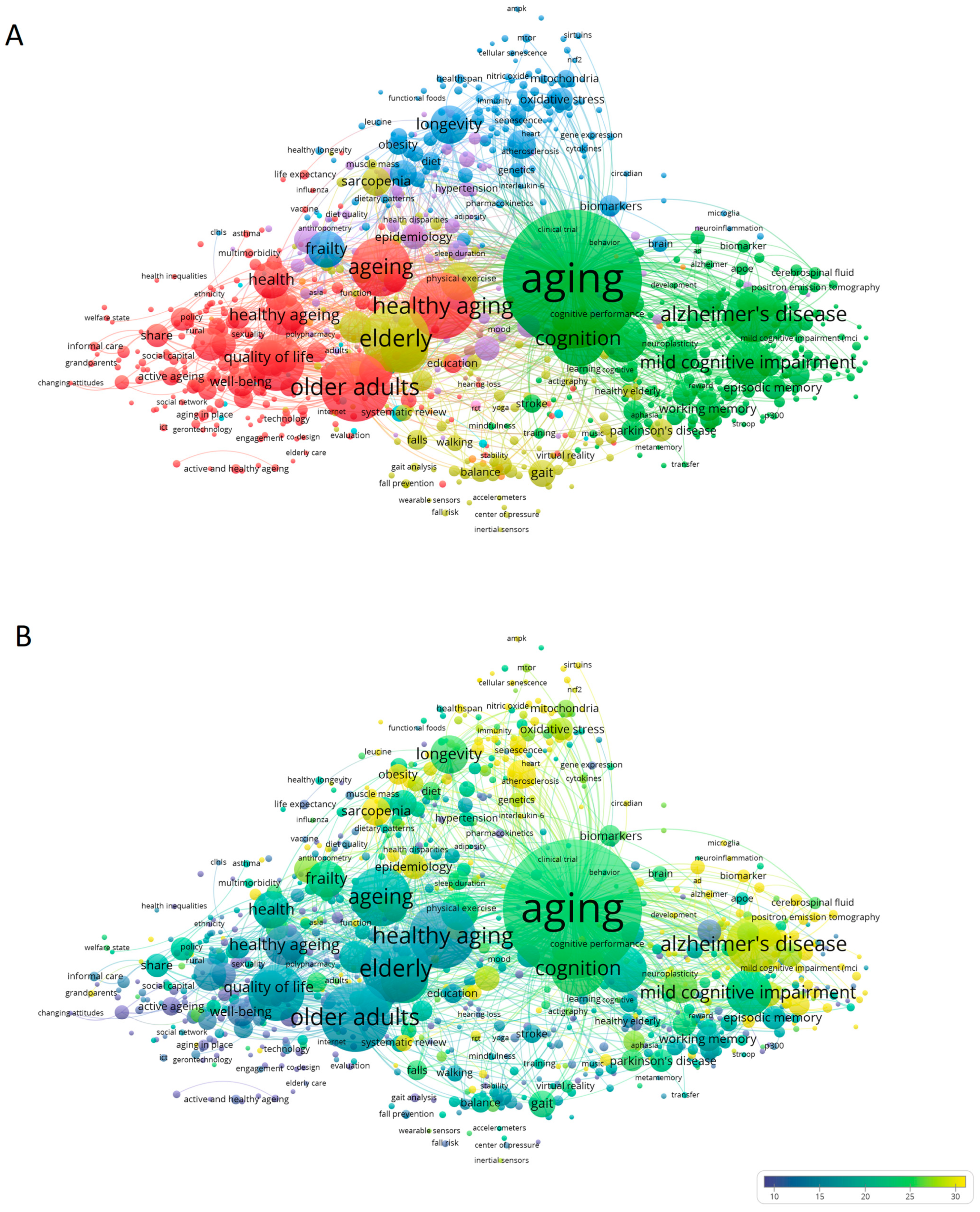
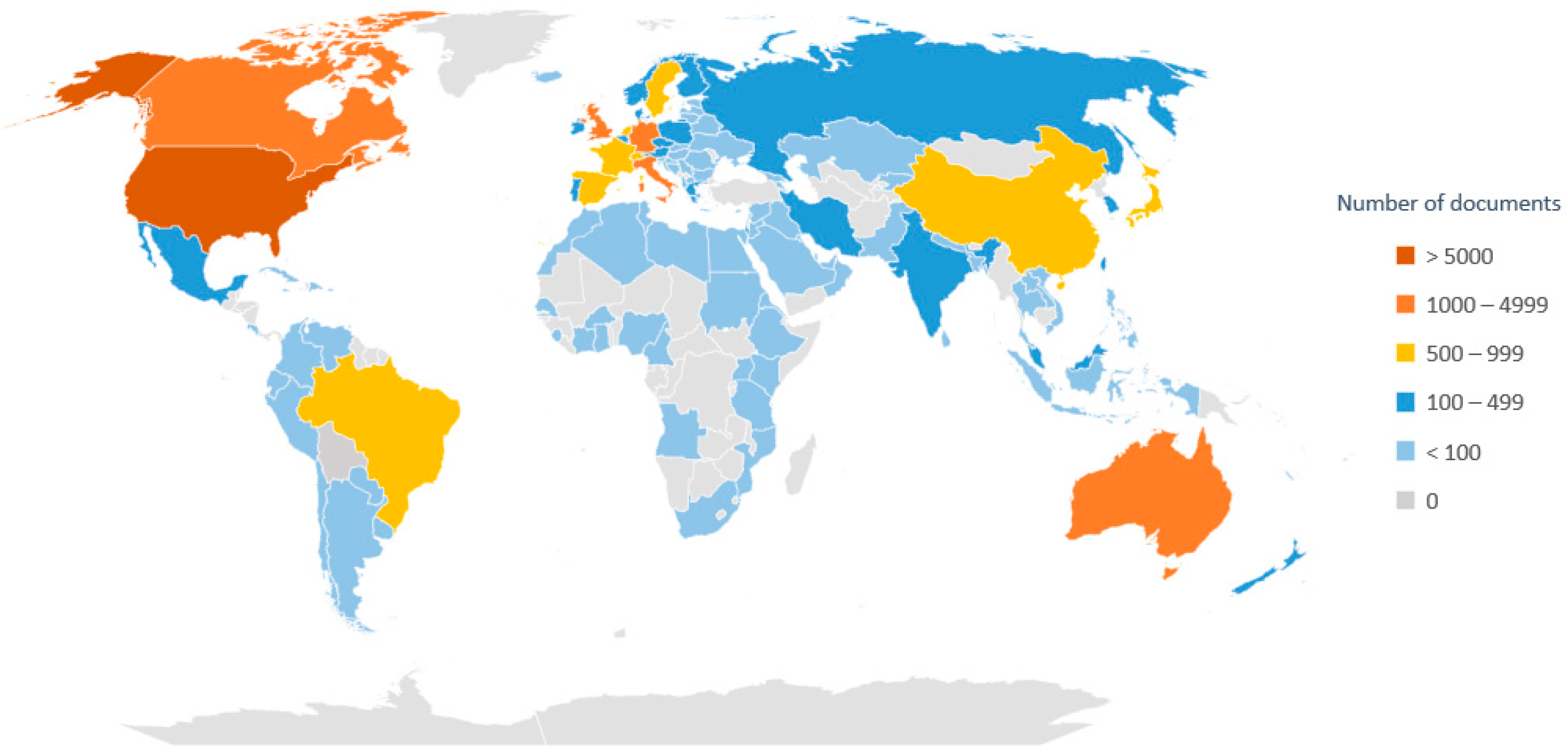
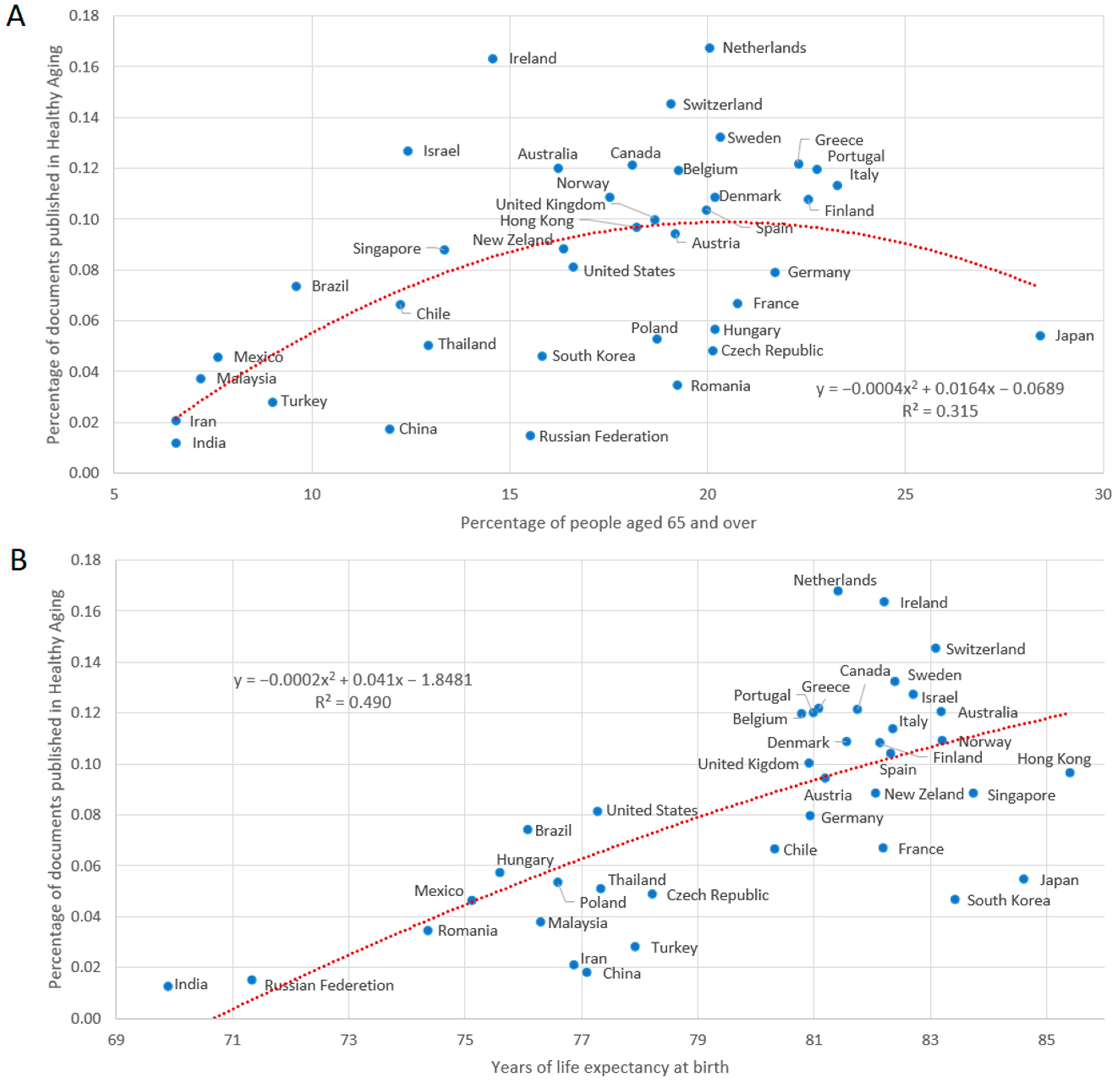
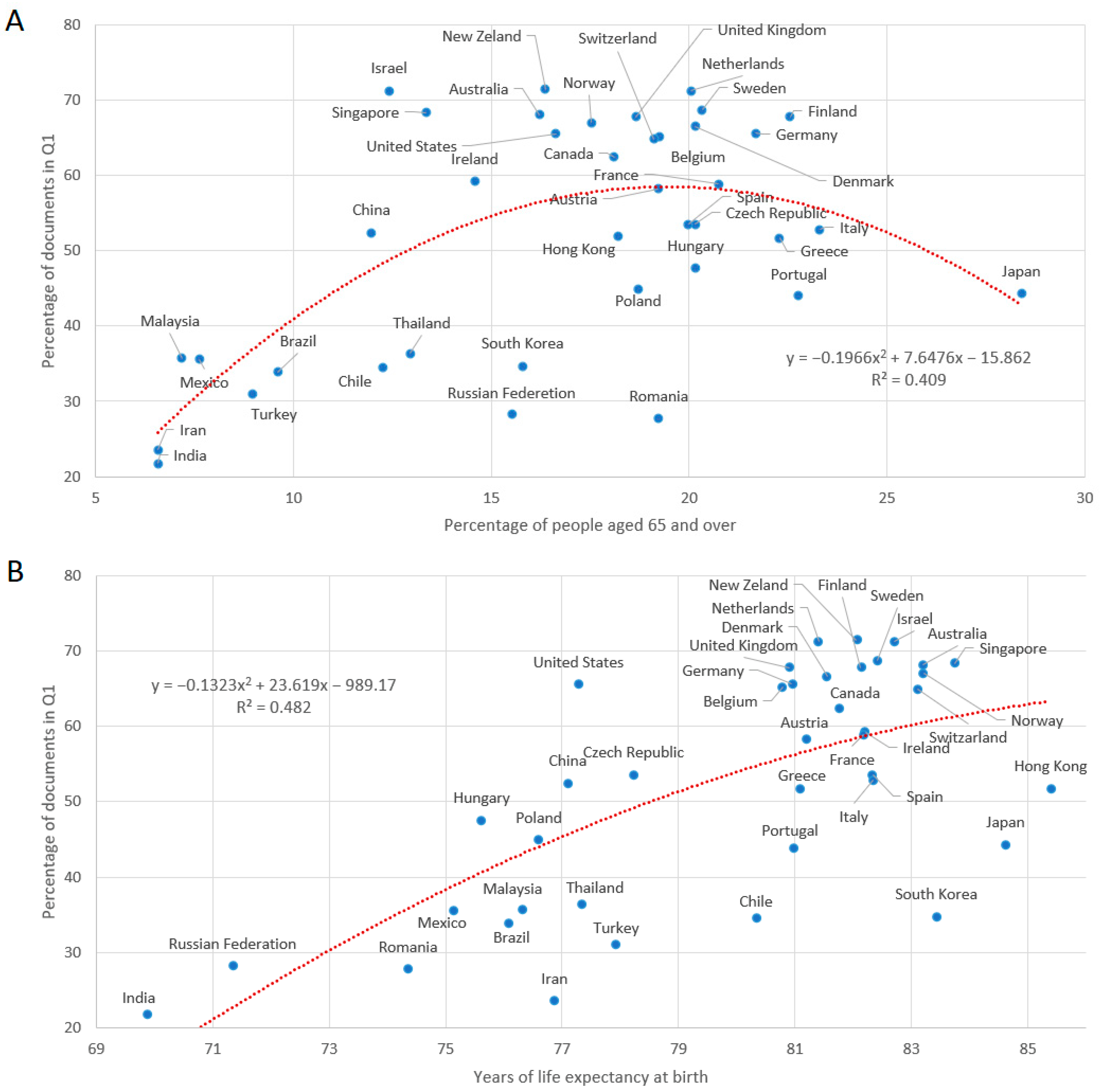
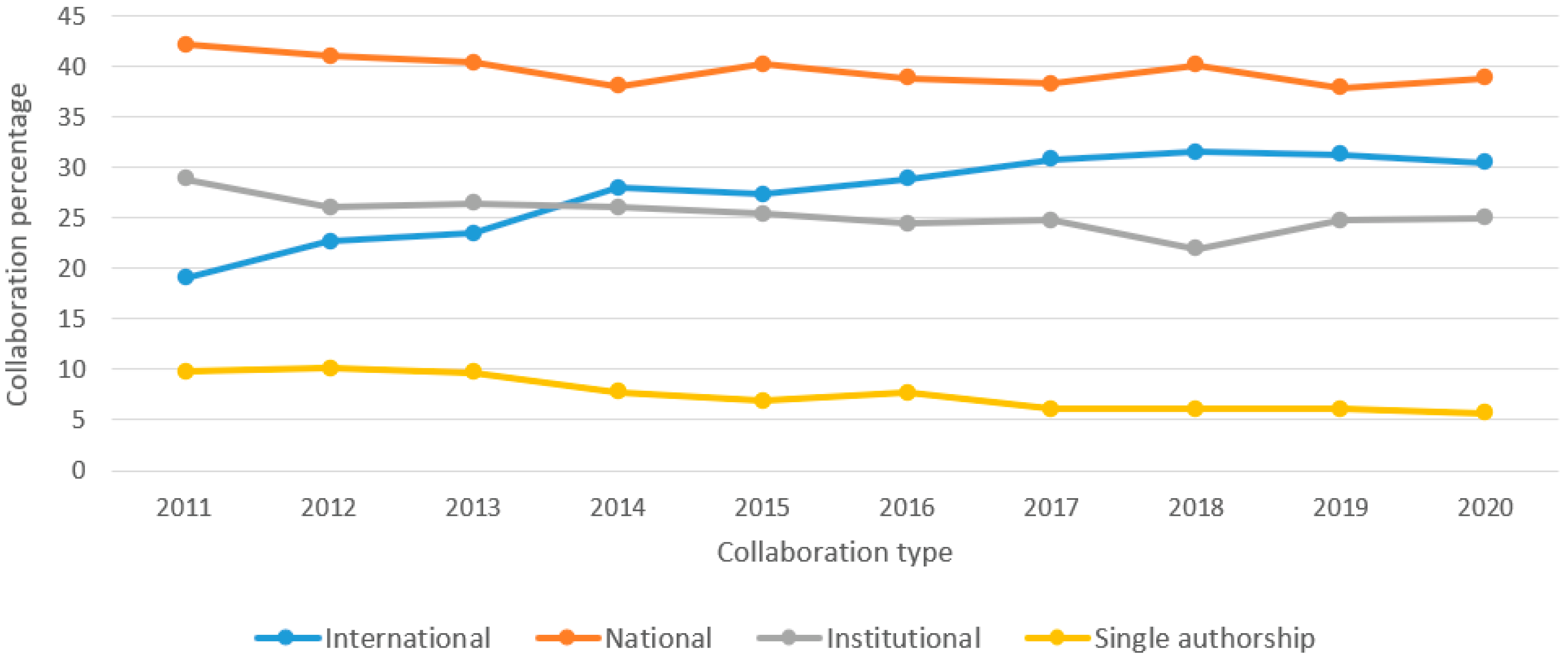
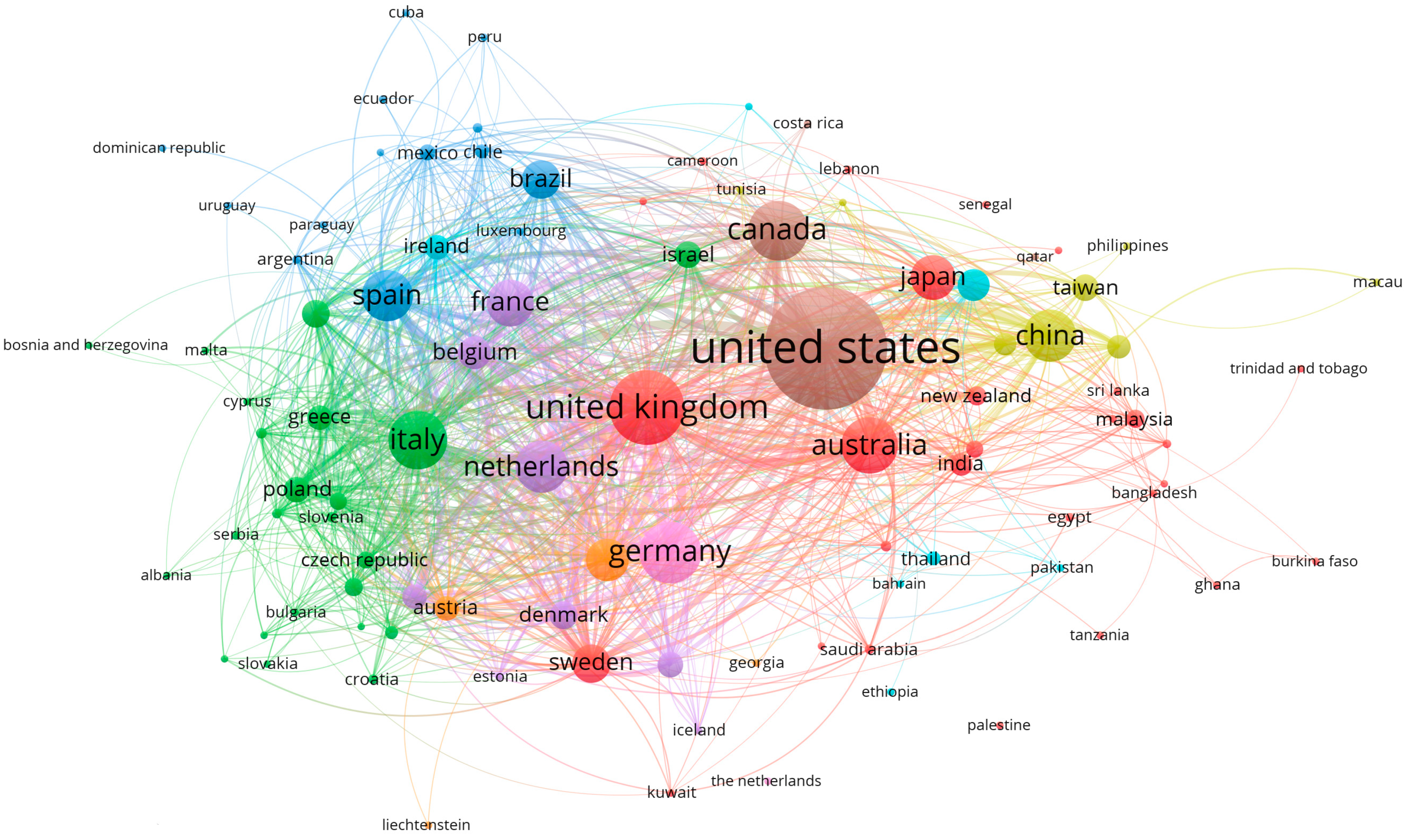
| # | Authors | Title | Year | Journal | Cited by | Document Type | Open Access |
|---|---|---|---|---|---|---|---|
| 1 | Villeda S.A., Luo J., Mosher K.I., et al. [26] | The ageing systemic milieu negatively regulates neurogenesis and cognitive function | 2011 | Nature | 1004 | Article | All Open Access, Green |
| 2 | Studenski S.A., Peters K.W., Alley D.E., et al. [27] | The FNIH sarcopenia project: Rationale, study description, conference recommendations, and final estimates | 2014 | Journals of Gerontology—Series A Biological Sciences and Medical Sciences | 1001 | Article | All Open Access, Green |
| 3 | Deeks S.G., Lewin S.R., Havlir D.V. [28] | The end of AIDS: HIV infection as a chronic disease | 2013 | The Lancet | 984 | Review | All Open Access, Green |
| 4 | Börsch-Supan A., Brandt M., Hunkler C., et al. [29] | Data resource profile: The survey of health, ageing and retirement in Europe (share) | 2013 | International Journal of Epidemiology | 789 | Article | All Open Access, Bronze, Green |
| 5 | Pahor M., Guralnik J.M., Ambrosius W.T., et al. [30] | Effect of structured physical activity on prevention of major mobility disability in older adults: The LIFE study randomized clinical trial | 2014 | JAMA—Journal of the American Medical Association | 747 | Article | All Open Access, Bronze, Green |
| 6 | Powe C.E., Evans M.K., Wenger J., et al. [31] | Vitamin D-binding protein and vitamin D status of black Americans and white Americans | 2013 | New England Journal of Medicine | 744 | Article | All Open Access, Green |
| 7 | Martin-Montalvo A., Mercken E.M., Mitchell S.J., et al. [32] | Metformin improves healthspan and lifespan in mice | 2013 | Nature Communications | 739 | Article | All Open Access, Bronze, Green |
| 8 | Kanfi Y., Naiman S., Amir G., et al. [33] | The sirtuin SIRT6 regulates lifespan in male mice | 2012 | Nature | 683 | Article | - |
| 9 | Swanson D., Block R., Mousa S.A. [34] | Omega-3 fatty acids EPA and DHA: Health benefits throughout life | 2012 | Advances in Nutrition | 654 | Review | All Open Access, Bronze, Green |
| 10 | Williams A.R., Hare J.M. [35] | Mesenchymal stem cells: Biology, pathophysiology, translational findings, and therapeutic implications for cardiac disease | 2011 | Circulation Research | 649 | Review | All Open Access, Bronze, Green |
Publisher’s Note: MDPI stays neutral with regard to jurisdictional claims in published maps and institutional affiliations. |
© 2022 by the authors. Licensee MDPI, Basel, Switzerland. This article is an open access article distributed under the terms and conditions of the Creative Commons Attribution (CC BY) license (https://creativecommons.org/licenses/by/4.0/).
Share and Cite
Rojas-Montesino, E.; Méndez, D.; Espinosa-Parrilla, Y.; Fuentes, E.; Palomo, I. Analysis of Scientometric Indicators in Publications Associated with Healthy Aging in the World, Period 2011–2020. Int. J. Environ. Res. Public Health 2022, 19, 8988. https://doi.org/10.3390/ijerph19158988
Rojas-Montesino E, Méndez D, Espinosa-Parrilla Y, Fuentes E, Palomo I. Analysis of Scientometric Indicators in Publications Associated with Healthy Aging in the World, Period 2011–2020. International Journal of Environmental Research and Public Health. 2022; 19(15):8988. https://doi.org/10.3390/ijerph19158988
Chicago/Turabian StyleRojas-Montesino, Eric, Diego Méndez, Yolanda Espinosa-Parrilla, Eduardo Fuentes, and Iván Palomo. 2022. "Analysis of Scientometric Indicators in Publications Associated with Healthy Aging in the World, Period 2011–2020" International Journal of Environmental Research and Public Health 19, no. 15: 8988. https://doi.org/10.3390/ijerph19158988
APA StyleRojas-Montesino, E., Méndez, D., Espinosa-Parrilla, Y., Fuentes, E., & Palomo, I. (2022). Analysis of Scientometric Indicators in Publications Associated with Healthy Aging in the World, Period 2011–2020. International Journal of Environmental Research and Public Health, 19(15), 8988. https://doi.org/10.3390/ijerph19158988








